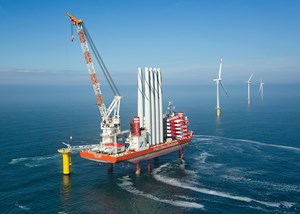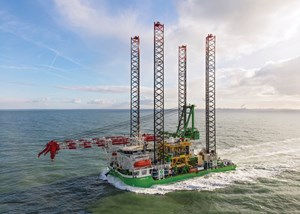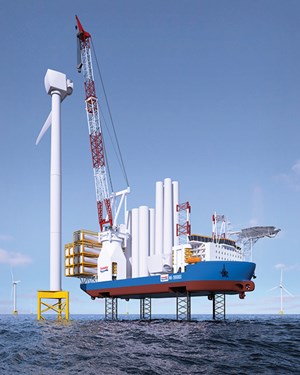Offshore wind developments pushing purposeful innovations
The offshore wind turbine installation market has matured significantly over the last decade. For the inexperienced observer, or even for some seasoned offshore professionals, the applied installation methods in Europe are all more, or less, the same. However, only a few of the existing installation vessels will be suitably equipped to meet the demands of the next-generation turbines. To avoid an installation bottleneck, designers and equipment suppliers will remain focused on purposeful innovation.
Wind turbine manufacturers will be eager to explain the big differences between their own and competitors’ turbines. The installation contractors bring their own expertise to the job and will confirm that every single installation site, and even every single turbine location, can be vastly different. Also, the designers of the installation jackups with dedicated cranes are always keen to point out the different capabilities between the units.
Nonetheless, from a global perspective, insights gained over the last decade have led to convergence in applied methods and technology. As long as none of the input parameters, such as turbine sizes, environment and logistical infrastructure radically changes, it will be extremely difficult for innovative concepts to enter the market. Why is this the case?
- Developers have mastered the process of efficient field development, understand the risks, and hence have honed their skills of efficient project execution.
- Wind turbine manufacturers know the current installation equipment, understand its potential and limitations, and have found a good balance between modifying the scope (turbine) and requiring modifications to the installation jackups with their specialized cranes.
- Designers with proven products have met their promises in terms of timely delivery and delivery to specifications. This avoids both the time risk and technical risk.
- Yards like to price equipment that they know, since they can manage the risk. There is no need to include extra-risk premium, and they can reliably predict the time to delivery.
Nevertheless, the same industry is challenged to have sufficient and capable installation equipment in time to meet the installation demands of the next-generation turbines. This requires developers to provide a sufficient pipeline of work, to allow the contractors to invest in new equipment, and requires designers and equipment suppliers to keep focusing on purposeful innovation, and being faster and more efficient, while maintaining or improving safety.
FASTER, MORE EFFICIENT INSTALLATION

Recent developments in turbine sizes, weights, and especially required installation heights, have pushed designers to come up with new solutions. Dutch offshore engineering and consultancy company GustoMSC has been actively engaged in offshore wind since the start of this century and is now a world-leading jackup installation vessel developer, with almost 70% market share, Fig. 1.
The company is an important player in the energy transition field, as it enables firms to operate more efficiently and sustainably in both the offshore wind energy and offshore oil-and-gas markets. Recently, GustoMSC introduced innovative solutions related to installation jackups.
OPERATOR SUPPORT SOFTWARE
GustoMSC developed the new Operator Support System (OSS), to enable an operator to work more efficiently. The operator can maximize efficiency by having all relevant information available in real time. At the same time, safety is maximized, because the information of multiple sub-systems can be combined, and manual misinterpretation can be prevented. The OSS connects systems, extracts and intelligently combines the available data, and translates the relevant information into key operational support.

By coupling real-time foundation loads and the crane operation, OSS can unlock the full potential of the jackup unit, Fig. 2. GustoMSC’s proprietary pre-torque technique optimizes the distribution of foundation loads between the jackup legs, providing maximum crane capacity for lifting operations. To put it simply, the load on the leg, where the crane is positioned, can be reduced by operating the jacking system, thus creating leg load capacity to be utilized by the crane operation. As a result, the crane can be used at maximum capacity. In this manner, jackup platforms can be outfitted with larger cranes without compromising safety.
This means that the introduction of new risks is limited and, in fact, one of the larger industry risks, like soil-bearing failure during heavy crane operations and consequential potentially disastrous leg settlement, is fully mitigated.
TELESCOPIC LEG CRANE

Around the leg, the telescopic crane offers an innovative combination of high hoisting height for wind turbine installation and heavy load capability for foundation installation. By introducing a telescopic boom that features a very high hook height when extended (1,250 metric tons at 160 m), and offers an increased hoisting capacity when retracted (2,500 metric tons at 120 m), it is possible to break the cycle of extremely long protruding booms and increasing crane weights. This results in a more economic crane design and increased variable load available for operations, Fig. 3.
In 2019, Japanese construction conglomerate Shimizu Cooperation awarded the first contract for this telescopic leg crane. The reason that such an innovation could be successful, regardless of the risk-averse attitude of the relevant parties involved, is because existing solutions could simply not cope with the considerable heights and weights.
In addition, by building and demonstrating full functionality with a large-scale model, the perceived risks were mitigated.
ENERGY STORAGE SYSTEMS
ON WTIVS
Another development that has recently gained more traction is the optimization of power generation and consumption. Storing energy on a temporary basis is a way to contribute to increased sustainability. A Wind Turbine Installation Vessel (WTIV) has a highly fluctuating power profile during a turbine offshore installation campaign, and is therefore perfectly suitable for implementation of energy storage solutions.
WTIV: CHANGING PERSPECTIVE ON STORAGE
Only a few years ago, energy storage solutions seemed relatively inefficient. It was challenging to make a convincing case to demonstrate both the operational benefits and the reduced carbon footprint.
Since then, however, a combination of factors has led to significant changes in thinking. The increasing size of wind turbine components, requiring larger installation vessels, is one key element in this shift. Bigger installation vessels require a significantly larger propulsion plant for dynamic positioning, while at the same time, the required power during idling, waiting for weather, loading in harbor, or even installing wind turbines on-site, has only risen moderately.
In addition, significant improvements have been made on hull resistance in recent years, reducing power requirements for transit conditions. This often makes the power required for dynamic positioning the dominant driver. The high demand for power for a relatively short period, leading to a fluctuating power profile, is ideally suited to temporary energy storage systems. And last but not least, energy storage solutions have matured significantly in terms of technology. The capital cost has dropped ($/kWh) while energy density (kWh/kg) and energy efficiency have increased substantially.
ENERGY STORAGE APPLICATION
When it comes to the latest generation of wind turbine installation vessels, GustoMSC takes a case-by-case approach to assess whether implementation of energy storage systems is beneficial and supported by the end-customer. For example, when the power requirements during leg handling and DP operations are well above what is needed for transit, batteries can be an attractive option.
A WTIV arrives on site after several hours in transit, with relatively predictable power consumption. During this period, the batteries can be charged. If a minimum filling rate can be guaranteed, and DP operations are time-limited and relatively predictable, batteries can be an effective solution. Rather than an extra generator set, batteries can be installed to supply short-term, extra peak power.
In addition, batteries can supply instant power, so operators don’t have to rely on spinning reserve, generators running on stand-by, to guarantee sufficient power is available to maintain position during a generator failure.
Furthermore, a battery on stand-by is not using fuel or wasting running hours, offering an effective and clean alternative.
STORE AND REUSE ENERGY
Today, advances in battery technology have made it possible to effectively store and feed power back into the batteries, instead of dissipating the energy via resistor banks. This application could be useful for jacking down, lowering legs to the seabed, lowering the crane boom, lowering the hook, and so on.
GustoMSC has developed an integrated solution, where the jacking system and crane are combined with a main vessel DC grid and battery packs. To be effective, the system needs proper integration, customized to the specific WTIV particulars and client operating profile. This is essential for cost-effectiveness, reduced running hours, and an overall reduced carbon footprint.
FUTURE OUTLOOK
GustoMSC measures all new inventions against the yardstick of current equipment performance and methods. They need to be faster, more efficient or have a reduced environmental footprint and preferably a combination of those.
The successful developments mentioned above are examples of purposeful innovation: resolving a specific need, while limiting impact on related equipment. These innovations serve as enablers for the installation of the bigger next-generation wind turbines.
- Coiled tubing drilling’s role in the energy transition (March 2024)
- Advancing offshore decarbonization through electrification of FPSOs (March 2024)
- Subsea technology- Corrosion monitoring: From failure to success (February 2024)
- Executive viewpoint: TRRC opinion: Special interest groups are killing jobs to save their own (February 2024)
- Driving MPD adoption with performance-enhancing technologies (January 2024)
- Digital transformation: A breakthrough year for digitalization in the offshore sector (January 2024)
- Applying ultra-deep LWD resistivity technology successfully in a SAGD operation (May 2019)
- Adoption of wireless intelligent completions advances (May 2019)
- Majors double down as takeaway crunch eases (April 2019)
- What’s new in well logging and formation evaluation (April 2019)
- Qualification of a 20,000-psi subsea BOP: A collaborative approach (February 2019)
- ConocoPhillips’ Greg Leveille sees rapid trajectory of technical advancement continuing (February 2019)


